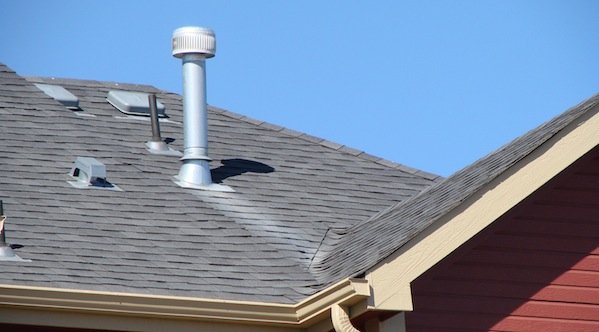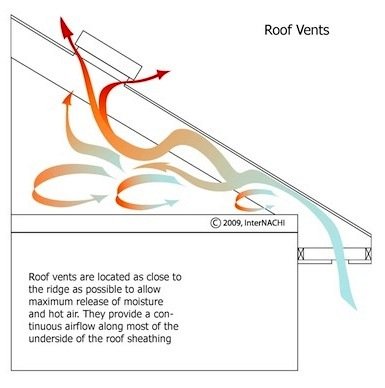Roofing and Attic Ventilation
/Although you probably don't give your roof ventilation much thought on a daily basis, it is crucial to many aspects of daily life in your home. The longevity of your roof system, your family's comfort and wellbeing, your potential future home repair costs, and how much you pay for heating and cooling can all benefit from having adequate attic ventilation.
Why Attic Ventilation is Important
To prevent extra heat and moisture from harming your property, make sure your attic has adequate ventilation. The heat from the sun hammering down on the roof can raise the temperature in the attic, which can warp the roof sheathing and cause the shingles to damage and age prematurely. It might be more difficult and costly to maintain a comfortable indoor climate in finished living areas if the attic floor is not evenly and sufficiently insulated. Warm air that has been heated in the living space below escapes into the attic in locations where winter temperatures drop below freezing, rising to the underside of the roof deck. The bottom layer of the snow accumulation on the rooftop starts to melt as the roof deck warms, which results in water trickling down the roof. Runoff turns back into ice once it reaches the frigid outer border. When this occurs regularly, an ice dam builds along the eaves, preventing additional runoff from escaping. When water is stuck somewhere, it may back up beneath the shingles.
How Attic Ventilation Works
In an unfinished attic, intake vents along the soffits and exhaust vents at the peak or roof ridge are typically required for effective ventilation. This enables the air to circulate continuously through the area. Through the soffit vents, cooler outside air is brought in, while the vents along the roof ridge allow warm, humid air that has migrated to the roof's highest point to escape.
The last line of protection against ice damming is a properly fitted self-adhered underlayment. This waterproofing compound forms a tight seal around nails and is tear-resistant. It aids in preventing water overflow from entering exterior walls or the attic, where it may otherwise soak up the insulation beneath the floor, destroy the drywall, or infiltrate inner walls.
Identifying the Symptoms of Poor Ventilation
Multiple issues that present in various ways can be brought on by an insufficient attic ventilation system.
Here are some things to be on the lookout for, both subtle and not so subtle:
A sudden increase in your household's energy costs, which may occur if the attic insulation becomes moist and loses its efficiency.
HVAC repairs will be required more frequently since machinery that is working harder may be more prone to malfunctions or even early failure.
A discernible accumulation of ice along the edge of your roof throughout the winter
The roofline and shingles of your home have a waved or rippled appearance because the decking underneath has warped due to moisture damage.
Metal objects in the attic that have rust and corrosion, such as nail heads, electrical boxes, light fixtures, and HVAC system parts
Any signs of condensation, water damage, frost, or stains on the roof sheathing of your attic, as well as any signs of degeneration and decay of the roof's structural supports
An increase in your family's allergy or respiratory issues, which could be caused by the spores of mold growing in your attic spreading through the air you breathe indoors.
Be sure to keep safety in mind if you decide to look for these indications in your attic or on your roof. Instead of ascending to the roof, walk around the outside of your house and use a pair of binoculars to look up from the ground level. Make sure the attic is well-lit, that you have a secure path to follow, and that you are wearing the right safety gear before you go up there.
How to Fix a Poorly Ventilated Attic
Building codes normally call for one square foot of net free-vent area (NFVA) per 300 square feet of space in an unfinished attic, so it's a good idea to get your attic checked by a licensed roofing contractor if you notice any of the above warning signals or have worries about them. If more is required, they can provide you advice on the best ways to increase ventilation and ensure its efficacy. To achieve this, they will consider a number of things, such as the weather where you live, the shape of your roof, how old your shingles are, the decking and other roof elements’ current condition, and ff your attic floor is properly sealed and insulated.
The following procedures to properly ventilate your attic may be advised if your roof is towards the end of its useful life, the decking is damaged, or other components are degraded: installing continuous soffit vents along the outer edge of the eaves, sealing the attic floor to make it airtight, and making sure there’s the recommended R-value of properly-installed insulation in place and without it blocking the soffit vents, allowing one to two inches of air space between the installed insulation and roof sheathing, adding a ridge vent, and insulating along the top plates to meet or exceed the R-value already in the walls.



